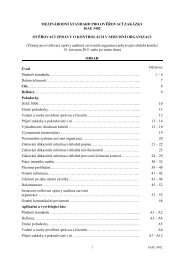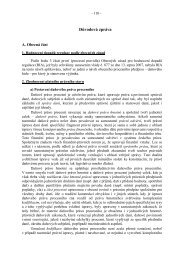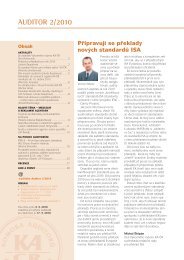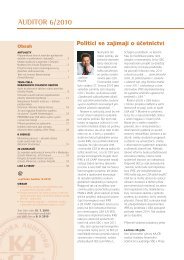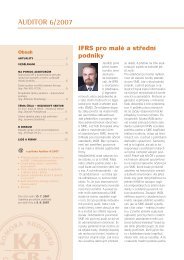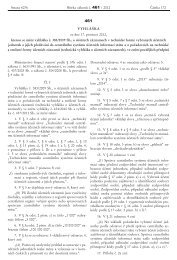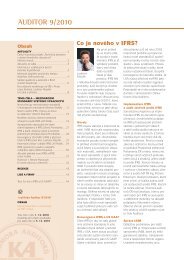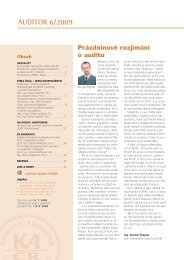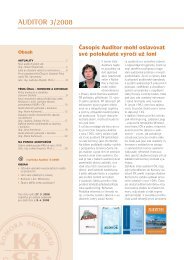Guide to Using International Standards on Auditing in - IFAC
Guide to Using International Standards on Auditing in - IFAC
Guide to Using International Standards on Auditing in - IFAC
Create successful ePaper yourself
Turn your PDF publications into a flip-book with our unique Google optimized e-Paper software.
11<br />
<str<strong>on</strong>g>Guide</str<strong>on</strong>g> <str<strong>on</strong>g>to</str<strong>on</strong>g> <str<strong>on</strong>g>Us<strong>in</strong>g</str<strong>on</strong>g> <str<strong>on</strong>g>Internati<strong>on</strong>al</str<strong>on</strong>g> <str<strong>on</strong>g>Standards</str<strong>on</strong>g> <strong>on</strong> <strong>Audit<strong>in</strong>g</strong> <strong>in</strong> the Audits of Small- and Medium-Sized Entities Volume 1—Core C<strong>on</strong>cepts<br />
• Policies and procedures that provide additi<strong>on</strong>al accountability, such as signed approval for journal<br />
entries;<br />
• Improved access c<strong>on</strong>trols for sensitive data and transacti<strong>on</strong>s;<br />
• Silent alarms;<br />
• Discrepancy and excepti<strong>on</strong> reports;<br />
• Audit trails;<br />
• Fraud c<strong>on</strong>t<strong>in</strong>gency plans;<br />
• Human resource procedures such as identify<strong>in</strong>g/m<strong>on</strong>i<str<strong>on</strong>g>to</str<strong>on</strong>g>r<strong>in</strong>g <strong>in</strong>dividuals with above-average fraud<br />
potential (for example, an excessively lavish lifestyle); and<br />
• Mechanisms for report<strong>in</strong>g potential frauds an<strong>on</strong>ymously.<br />
Entity-Level C<strong>on</strong>trols<br />
Entity-level c<strong>on</strong>trols address pervasive risks. They set the “<str<strong>on</strong>g>to</str<strong>on</strong>g>ne at the <str<strong>on</strong>g>to</str<strong>on</strong>g>p” of an organizati<strong>on</strong> and establish<br />
expectati<strong>on</strong>s for the c<strong>on</strong>trol envir<strong>on</strong>ment. They are often less tangible than c<strong>on</strong>trols that operate at the<br />
transacti<strong>on</strong> level, but have a pervasive and significant impact and <strong>in</strong>fluence over all other <strong>in</strong>ternal c<strong>on</strong>trols. As<br />
such, they form the all-important foundati<strong>on</strong> up<strong>on</strong> which other <strong>in</strong>ternal c<strong>on</strong>trols (if any) are built. Examples of<br />
entity level c<strong>on</strong>trols <strong>in</strong>clude management’s commitment <str<strong>on</strong>g>to</str<strong>on</strong>g> ethical behavior, attitudes <str<strong>on</strong>g>to</str<strong>on</strong>g>ward <strong>in</strong>ternal c<strong>on</strong>trol,<br />
hir<strong>in</strong>g and competence of staff employed, and anti-fraud and period-end f<strong>in</strong>ancial report<strong>in</strong>g. These c<strong>on</strong>trols<br />
will have an impact <strong>on</strong> all other bus<strong>in</strong>ess processes with<strong>in</strong> the entity.<br />
Management<br />
The pers<strong>on</strong>(s) with executive resp<strong>on</strong>sibility for the c<strong>on</strong>duct of the entity’s operati<strong>on</strong>s. For some entities <strong>in</strong><br />
some jurisdicti<strong>on</strong>s, management <strong>in</strong>cludes some or all of those charged with governance—for example,<br />
executive members of a governance board, or an owner-manager.<br />
Those Charged With Governance (TCWG)<br />
The pers<strong>on</strong>(s) or organizati<strong>on</strong>(s) (for example, a corporate trustee) with resp<strong>on</strong>sibility for oversee<strong>in</strong>g the<br />
strategic directi<strong>on</strong> of the entity and obligati<strong>on</strong>s related <str<strong>on</strong>g>to</str<strong>on</strong>g> the accountability of the entity. This <strong>in</strong>cludes<br />
oversee<strong>in</strong>g the f<strong>in</strong>ancial report<strong>in</strong>g process. For some entities, <strong>in</strong> some jurisdicti<strong>on</strong>s, those charged with<br />
governance may <strong>in</strong>clude management pers<strong>on</strong>nel—for example, executive members of a governance board<br />
of a private or public sec<str<strong>on</strong>g>to</str<strong>on</strong>g>r entity, or an owner-manager.<br />
Owner-Manager<br />
This refers <str<strong>on</strong>g>to</str<strong>on</strong>g> the proprie<str<strong>on</strong>g>to</str<strong>on</strong>g>rs of an entity <strong>in</strong>volved <strong>in</strong> the runn<strong>in</strong>g of the entity <strong>on</strong> a day-<str<strong>on</strong>g>to</str<strong>on</strong>g>-day basis. In most<br />
<strong>in</strong>stances, the owner-manager will also be the pers<strong>on</strong> charged with governance of the entity.<br />
Small- and Medium-Sized Account<strong>in</strong>g Practices/Firms (SMP)<br />
Account<strong>in</strong>g practices/firms that exhibit the follow<strong>in</strong>g characteristics: its clients are mostly small- and mediumsized<br />
entities (SMEs); external sources are used <str<strong>on</strong>g>to</str<strong>on</strong>g> supplement limited <strong>in</strong>-house technical resources; and it<br />
employs a limited number of professi<strong>on</strong>al staff. What c<strong>on</strong>stitutes an SMP will vary from <strong>on</strong>e jurisdicti<strong>on</strong> <str<strong>on</strong>g>to</str<strong>on</strong>g><br />
another.




